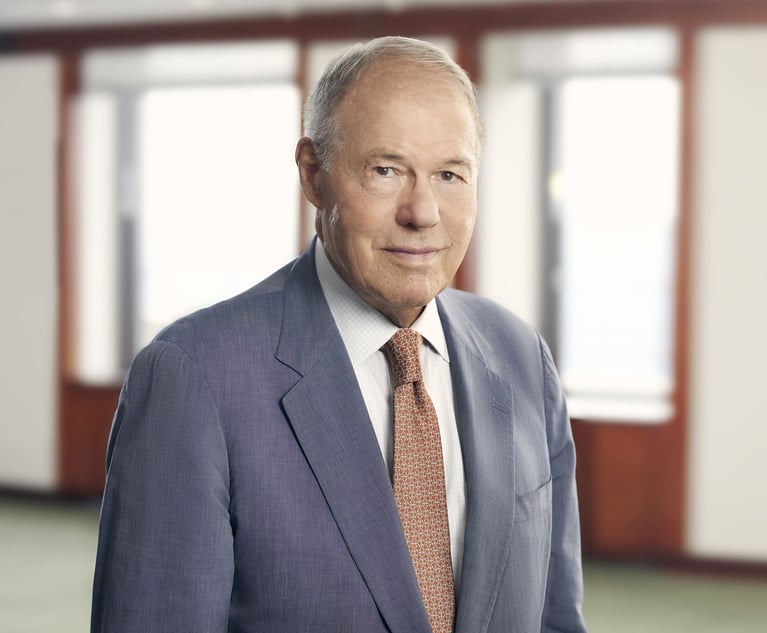Battles Over Jewish Religious Enclosures Test Towns Along NJ/NY Border
Recent settlements with two of three New Jersey border towns sued over their attempts to block the enclosures known as eruvs have settled, even as a town across the border in New York recently announced similar considerations.
March 05, 2018 at 04:46 PM
10 minute read
 An eruv is a defined space that permits Jews with certain religious beliefs to push and carry objects within its bounds during the Sabbath and Yom Kippur. Photo Credit: Wiki
An eruv is a defined space that permits Jews with certain religious beliefs to push and carry objects within its bounds during the Sabbath and Yom Kippur. Photo Credit: Wiki
In recent months, a trio of New Jersey towns huddled against the border with New York's Rockland County have tried to keep the local Orthodox Jewish community from constructing religious boundaries called eruvs that require PVC piping or wooden slats to be installed on utility poles.
Recently, two of the New Jersey towns, Mahwah and Montvale, have settled with the Orthodox community, allowing them to move forward with installation of the religious enclosures where needed. The settlements will remain under the jurisdiction of U.S. District Judge John Michael Vazquez of the District of New Jersey. Discussions with the third town, Upper Saddle River, New Jersey, are ongoing, but prospects for a resolution that allows for the eruv to go forward remain positive, according to those involved.
The three towns are the latest locales to attempt to block the installation of eruvs. And, like the ones before them, appear headed towards similar defeat over the same set of religious freedom concerns that sunk previous efforts, according to the legal team representing the Jewish community. Even as the New Jersey towns end their trek on the well-worn path of resistance followed by settlement or court-enforced acceptance, observers said a nearby town in New York may be looking to follow suit with new ordinances that may have the effect of keeping eruvs from being established in the community.
“The cases that are brought to try to stop an eruv are never really about the eruv,” said Weil, Gotshal & Manges partner Yehudah Buchweitz, who's led the legal battle against the towns' efforts to block the installations.
The latest battles over these most recent eruv installations, which allow observant Jews to do things like push strollers or carry house keys during the sabbath, come after a five-year battle in nearby Tenafly, New Jersey, that saw officials in that town forced in 2006 to allow the eruv to be installed after the U.S. Supreme Court declined to hear the case following a ruling in favor of the eruv proponents by the U.S. Court of Appeals for the Third Circuit. Tenafly was followed by a battle over plans to construct an eruv in communities in the Hamptons on Long Island. That years-long battle likewise ended with settlements, the last coming with Westhampton Beach, in June 2016.
Despite the end results in Tenafly and the Hamptons—only the most recent to have tried and failed to restrict eruv constructions—residents and officials in the three border towns have plunged themselves, to varying degrees, into attempts to thwart the installation of the eruv.
For members of the Orthodox community, the need for an eruv is clear. The stricture against pushing strollers or wheelchairs means members are unable to join the community during the Sabbath and Yom Kippur. Most of the community members are located on the New York side of the border, but, given the layout of streets and natural obstructions, to include all the members of a given community inside an eruv, the religious boundaries that run along the power lines needed to extend across the border into New Jersey.
Beginning in 2015, the Orthodox community sought to rectify this situation with the establishment of a small carve out into Upper Saddle River. Plans to create extensions into the other two towns were created over the next two years. According to those involved, the proper process was followed: the local utilities company, Orange & Rockland Utilities, was contacted, permits were paid for, and local police reached out to make sure the installations were going forward appropriately.
That work went unnoticed for two years, members of the community said. Then, in 2017, a portion of the residents in the towns started taking notice.
“We had a meeting with all the towns,” Rabbi Chaim Steinmetz of the Vaad HaEruv, the group coordinating creation of the eruv in the towns, said. According to Steinmetz, officials started telling him they didn't have the right permitting, and not from the right people, which amounted to claims that the eruv was going up without permission—that is, the permission of the towns.
Cease and desist letters were issued, while vocal members of the community took to social media to voice their opposition—something that took Steinmetz and other community members by surprise.
“I couldn't believe what I was seeing. I couldn't believe it,” Steinmetz said. “All of a sudden, one day, it was like a fire broke out on social media. It was crazy.”
Resident groups like Citizens for a Better Upper Saddle River and Mahwah Strong came out strongly against plans to construct the eruv, Steinmetz said. In a phone interview, Mahwah Strong's attorney, Strasser & Associates senior associate Conrad Olear, told the New York Law Journal that the real issues at stake had been “hijacked by the emotion of the religious and the political issues.”
“I think that the rhetoric that this creates, and the undercurrent of the topic, creates the problem for a true analysis of the legal issues, and that can't be denied,” he said.
Olear and his clients, as well as town officials who've worked to impede the eruv installations, present the issue as one of local control—not anti-Semitism. In reality, according to Olear, there are two other First Amendment constitutional issues in play, namely the establishment clause and free exercise clause. Then there are state statutes in New Jersey regarding landowners with respect to utilities, he said, as well as municipal consent statutes for installation on telephone poles, and state Department of Transportation permitting issues.
“If you even reach a favorable constitutional win for the plaintiff in this matter, one could clearly argue that it would then turn on a town ordinance issue from a signage perspective,” Olear argued.
While each town has had its issues, Mahwah by far has been the most visible battle over the eruvs.
As Olear pointed out, the issue has not been seen as one of permits and ordinances, local landowner notification rights or municipal consent concerns. After the town council passed a rule that forbade nonresidents from using local parks amidst the ongoing eruv battle, the New Jersey state Attorney General's Office under Christopher Porrino sued the town over what it said was discriminatory practices. In a statement at the time, he likened the move to “1950s-era 'white flight' suburbanites who sought to keep African-Americans from moving into their neighborhoods.”
Not all of Mahwah's leaders has supported these efforts. From the very beginning of the controversy, Mayor William Laforet has been one of the most vocal, if lonely, voices in the town defending the eruv and the Orthodox community's rights in general. This has put him consistently at odds with other town elected officials and Mahwah Strong.
“The parent issue here is simple: You cannot violate the civil rights of human beings,” he said in an interview.
Laforet, who is facing an attempt to recall him over what he believes is his defense of the eruv, said the council's decisions have already cost the town as much as $275,000 in legal fees. These costs, not to mention the harm done to the town's reputation and those affected by the council's actions, are occurring pointlessly, according to Laforet, who disagreed sharply with Olear's position on the legal questions around establishing eruvs.
“This has been already proven in federal court. They have never lost,” he said.
Laforet insisted that, in the end, the majority of Mahwah's residents don't share the views of the eruv's opponents.
“I believe the vast majority of people understand the civil rights of human beings,” he said. “I do believe there's a very small, animated group of people who have not been allowed to review all the facts, or they would feel differently.”
The one person who arguably does have all the facts before him is Vazquez. As the federal suits filed by Weil over the eruv proceeded, Vazquez continually urged the parties to engage in talks to come to a resolution.
In early January, Vazquez provided his preliminary views on a preliminary injunction motion over an Upper Saddle River ordinance that was passed that barred the use of power line poles for postings that would have had the effect of stopping the creation of an eruv. Despite the town's arguments that stopping the eruv wasn't the explicit goal, Vazquez voiced concerns that a discriminatory intent was at play.
“I do strongly believe that this is a matter that the parties should be, if they're willing to be reasonable, reach a resolution on,” he told those present.
By late February, settlement agreements with Mahwah and Montvale were finalized with Weil. Discussions with Upper Saddle River are ongoing, but temporary accommodations have been put in place to allow Orthodox residents there the ability to move freely during the Sabbath and Yom Kippur.
Even as the New Jersey towns have moved towards resolution, across the border in New York similar issues have developed.
The town of Orangetown, which sits at the southern-most tip of Rockland County, is considering an ordinance that regulates the use of its utility poles. Specifically, the ordinance would appear to ban the installation of the wooden or plastic strips necessary for the creation of an eruv.
In a Feb. 15 letter, utility company Orange & Rockland's vice president of operations, Francis Peverly, raised a number of concerns with the proposed local law. Among them was the language about eruvs, which, according to Orange & Rockland, “ignores the existing and compelling legal precedent regarding the regulation” of eruv construction.
“Both federal and state courts have ruled that, because a wide variety of attachments are already legally allowed to be mounted on utility poles, eruv attachments cannot be excluded,” Peverly wrote.
Multiple attempts to reach Orangetown officials via telephone and email to confirm the status of the ordinance and for any comment were not returned.
Weil's Buchweitz noted that there was a somewhat surprising consistency in the resistance to eruvs in the greater New York City area. Other areas of the country have gone forward with eruvs largely without conflict, he noted. Recently, San Jose, California, became the last of the 10 biggest cities in the nation to establish one, and 23 of the top 25 by population now all have eruvs, according to Buchweitz.
“What's remarkable about it is that, in almost all of them, there's been no dispute,” he said. “There's a lot of parts of the country where, an eruv goes up and people say, 'Oh, that's nice.' It's another symbol of diversity.”
For the most part in New York and New Jersey, he added, things have also been generally amicable when Orthodox groups have sought to create an eruv.
“But somehow here there's still people who want to try to block religious Jews from moving into their towns,” he said. “It's sad and unfortunate, but we'll be here to help whoever needs it.”
This content has been archived. It is available through our partners, LexisNexis® and Bloomberg Law.
To view this content, please continue to their sites.
Not a Lexis Subscriber?
Subscribe Now
Not a Bloomberg Law Subscriber?
Subscribe Now
NOT FOR REPRINT
© 2025 ALM Global, LLC, All Rights Reserved. Request academic re-use from www.copyright.com. All other uses, submit a request to [email protected]. For more information visit Asset & Logo Licensing.
You Might Like
View All
Meet the Long Island Judge Tapped to Be US Attorney for Eastern District of New York
2 minute read
New York’s Property Tax Incentives and Abatements Make Development Feasible
7 minute read
Josef Partners With NYU, Housing Court Answers to Launch AI Assistant Built for Tenants

Trending Stories
Who Got The Work
Michael G. Bongiorno, Andrew Scott Dulberg and Elizabeth E. Driscoll from Wilmer Cutler Pickering Hale and Dorr have stepped in to represent Symbotic Inc., an A.I.-enabled technology platform that focuses on increasing supply chain efficiency, and other defendants in a pending shareholder derivative lawsuit. The case, filed Oct. 2 in Massachusetts District Court by the Brown Law Firm on behalf of Stephen Austen, accuses certain officers and directors of misleading investors in regard to Symbotic's potential for margin growth by failing to disclose that the company was not equipped to timely deploy its systems or manage expenses through project delays. The case, assigned to U.S. District Judge Nathaniel M. Gorton, is 1:24-cv-12522, Austen v. Cohen et al.
Who Got The Work
Edmund Polubinski and Marie Killmond of Davis Polk & Wardwell have entered appearances for data platform software development company MongoDB and other defendants in a pending shareholder derivative lawsuit. The action, filed Oct. 7 in New York Southern District Court by the Brown Law Firm, accuses the company's directors and/or officers of falsely expressing confidence in the company’s restructuring of its sales incentive plan and downplaying the severity of decreases in its upfront commitments. The case is 1:24-cv-07594, Roy v. Ittycheria et al.
Who Got The Work
Amy O. Bruchs and Kurt F. Ellison of Michael Best & Friedrich have entered appearances for Epic Systems Corp. in a pending employment discrimination lawsuit. The suit was filed Sept. 7 in Wisconsin Western District Court by Levine Eisberner LLC and Siri & Glimstad on behalf of a project manager who claims that he was wrongfully terminated after applying for a religious exemption to the defendant's COVID-19 vaccine mandate. The case, assigned to U.S. Magistrate Judge Anita Marie Boor, is 3:24-cv-00630, Secker, Nathan v. Epic Systems Corporation.
Who Got The Work
David X. Sullivan, Thomas J. Finn and Gregory A. Hall from McCarter & English have entered appearances for Sunrun Installation Services in a pending civil rights lawsuit. The complaint was filed Sept. 4 in Connecticut District Court by attorney Robert M. Berke on behalf of former employee George Edward Steins, who was arrested and charged with employing an unregistered home improvement salesperson. The complaint alleges that had Sunrun informed the Connecticut Department of Consumer Protection that the plaintiff's employment had ended in 2017 and that he no longer held Sunrun's home improvement contractor license, he would not have been hit with charges, which were dismissed in May 2024. The case, assigned to U.S. District Judge Jeffrey A. Meyer, is 3:24-cv-01423, Steins v. Sunrun, Inc. et al.
Who Got The Work
Greenberg Traurig shareholder Joshua L. Raskin has entered an appearance for boohoo.com UK Ltd. in a pending patent infringement lawsuit. The suit, filed Sept. 3 in Texas Eastern District Court by Rozier Hardt McDonough on behalf of Alto Dynamics, asserts five patents related to an online shopping platform. The case, assigned to U.S. District Judge Rodney Gilstrap, is 2:24-cv-00719, Alto Dynamics, LLC v. boohoo.com UK Limited.
Featured Firms
Law Offices of Gary Martin Hays & Associates, P.C.
(470) 294-1674
Law Offices of Mark E. Salomone
(857) 444-6468
Smith & Hassler
(713) 739-1250






